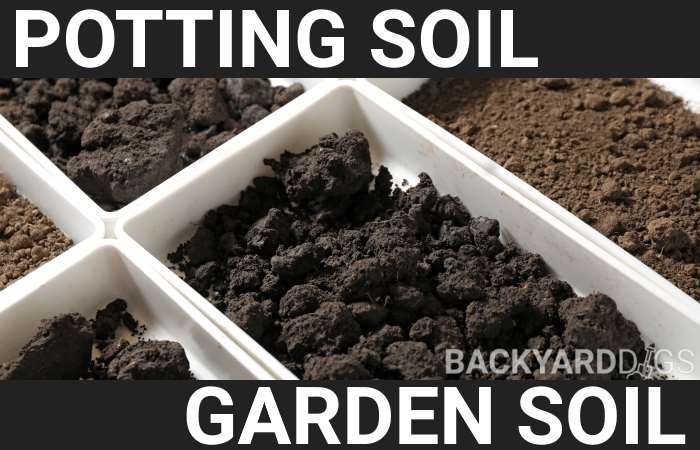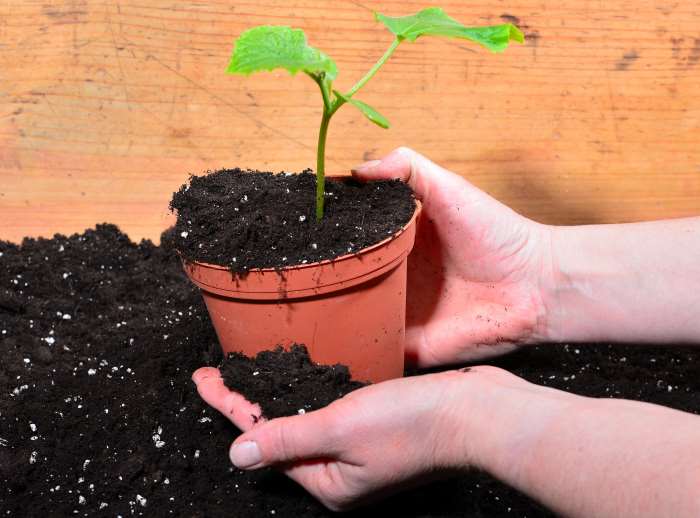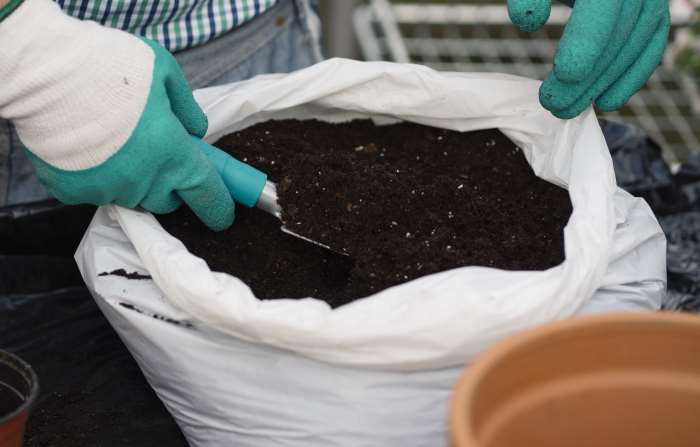Are you ready to fill your containers for planting and want to use garden soil leftover from last season?
While tempting to use up that dirt and get it out of your shed, using garden soil in potted planters can be detrimental to your plants’ health.

In this comparison guide, I explain the differences between potting soil vs. garden soil and the advantages and disadvantages of each.
I also answer common questions so you can use the right soil in the right place and keep all your garden plants happy and lush with flowers, fruits, and vegetables!
Difference Between Potting Soil And Garden Soil
Is potting soil really all that different from garden soil?
The answer is yes!

Potting soil is much more lightweight and is often sterile. Garden soil is heavier in texture and has more organic ingredients.
Using a lightweight growing medium in container pots helps keep them lighter so you can move your plants around without strain. The pot walls help support the soil and roots, so the plant can grow taller without falling over.

Garden soil is denser and allows flowers, vegetables, and shrubs to grow without the need for additional support.
Garden soil is also more generic, as it’s for general use in outdoor growing applications.
Potting soil comes in an array of mixtures specific to certain types of plants.
You can purchase blends ideal for cacti, succulents, or a blend perfect for the needs of orchids.
Related | Does Potting Soil Go Bad?
What Is Garden Soil Made Of?

Garden soil is a mixture of naturally occurring topsoil and a variety of organic material such as:
This blend increases the texture and nutritional value of the topsoil, so your garden plants have a better chance of healthy growth.
The texture is also able to hold more moisture, yet allow enough aeration to keep roots spreading vigorously.
Garden Soil Uses
Garden soil is best for use in vegetable plots or landscape planters.
You can use garden soil as a base inside raised beds and add amendments to the upper soil where the plants grow to achieve better drainage and texture.
If your existing soil is low-quality, you can add a six-inch-deep layer on top before transplanting to boost plant growth.
You can also work several inches of fresh garden soil into your vegetable garden plots each season to keep the soil in top condition.
Lastly, you can use garden soil to fill in divets or low spots in your lawn by sprinkling garden soil over the area and raking it in. The extra nutrients will help the grass grow and quickly fill in.
Related | Can You Use Garden Soil For Potted Plants?
Advantages:
- Provides dense soil that can support the root structure of plants
- Increases moisture retention
- Delivers natural organic minerals and nutrients to plants
- The soil can easily be amended to suit specific plant needs
Disadvantages:
- Can compact over time from walking, rain, and snowfall
- May retain too much moisture that rots out plant roots
- Nutrients get depleted as plants grow, so additional fertilizer will be necessary
What Is Potting Soil Made Of?

Most potting soil contains no actual soil at all. Potting soil mixes are usually a blend of:
- Peat moss
- Coconut coir
- Small bits of pine bark
- Perlite
- Vermiculite
- Lime to balance pH
Some potting mixes also add in some fertilizer or nutrients, so plants in pots have instant access to the food they need to grow.
Potting soil is often sterile. This treatment prevents fungi from overtaking the pot as there will be no microbes, such as those found in outdoor garden soil, to keep harmful mold in check.
Lastly, potting soil offers excellent drainage so roots won’t get Phytophthora and die off but still holds enough moisture for robust root development.
Uses For Potting Soil
Potting soil is the best solution to keep indoor and outdoor potted plants in excellent health.
Soil-free potting soil is best for indoor potted plants, while a soil-blend potting soil can also work outdoors.
You can use potting soil to amend dense outdoor garden soil with lots of clay or at the tops of raised-bed gardens to help with drainage issues.
Advantages:
- Lightweight, so pots are easy to move
- Excellent aeration
- Provides good drainage
- Less chance of disease or fungi development
- Absorbs and releases moisture as necessary
- Can purchase blends specific to certain plants
Disadvantages:
- Too lightweight to securely hold some tall plants
- Can be expensive to fill a lot of containers
- Some mixes use synthetic ingredients unsuitable for organic gardening
- Must provide additional fertilizer on a regular schedule
Related | How To Reuse Potting Soil
Soil FAQs
Can You Use Potting Soil In The Garden?
You can use potting soil as an amendment in your garden, but it’s not recommended for use as the only soil.
When you mix the light and airy consistency of potting soil into poor quality garden soil due to compaction or high clay levels, it helps aerate the soil and allow water to reach plant roots easier.
A deep layer of strictly potting soil in the garden may not provide enough structure to hold plants steady, especially once they grow tall and wind or rain add stress.
The best way to use potting soil in the garden is to dump out depleted soil from your pots and containers in the late fall and let it lay on the surface through the winter.
By letting the potting soil have exposure to sunlight, cold, and snow for several months, it will kill off any harmful fungi or bacteria before you till it into your garden come springtime, so they don’t harm your new plants.
Can You Use Garden Soil In Pots?
Sure, you can use garden soil in pots, but it’s not good for the plants you place inside as the material is denser and holds more moisture.
Excessive moisture causes molds to grow in the soil, increasing the likelihood of root rot developing and killing your plants.
Garden soil will also compact after many waterings, cutting off oxygen to plant roots, causing death.
If you want to use garden soil in containers to save on cost, please mix it well with bags of potting mix to keep the texture light and airy.
Is Garden Soil The Same As Compost?
No, garden soil is not compost. Garden soil is made up of organic materials like leaves, twigs, and even dead animals or insects that have decayed naturally, as well as inorganic components like rocks and minerals.
Compost is completely organic in nature. Compost is a human-made creation, formed from a mixture of leaves, grass, food scraps, paper products, wood, manure, and other nitrogen or carbon-based materials.
What Is Garden Mix Soil?
Garden mix soil is a blend of topsoil and compost, peat, or other ingredients.
A garden mix soil is optimal for healthy plant development because it includes nutrient-rich ingredients and adds in friendly soil microbes.
The best part about using a garden soil mix is not having to amend the garden soil yourself, which saves a lot of time and guesswork.










